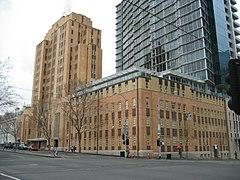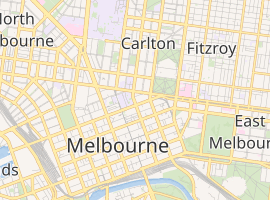| Russell Street Police Headquarters | |
|---|---|
 Russell St Police Headquarters | |
 | |
| General information | |
| Type | Moderne skyscraper style |
| Architectural style | Art Deco |
| Address | 336- 376 Russell Street |
| Town or city | Melbourne |
| Country | Australia |
| Coordinates | 37°48′30″S 144°57′58″E / 37.8082°S 144.9662°E |
| Construction started | 1940 |
| Opened | April 29, 1943[1][2][3] |
| Technical details | |
| Structural system | Reinforced concrete with face brick curtain walls on a plinth of Mt Difficult sandstone. |
| Floor count | 16 |
| Design and construction | |
| Architect | Percy Edgar Everett |
Russell Street Police Headquarters in Melbourne, on the north-eastern corner of Russell and La Trobe Streets, was well known as the headquarters of the Victoria Police through the second half of the 20th century, and was often referred to simply as 'Russell Street'.
The main impressive New York skyscraper style tower, recognised as a symbol of the police in Victoria,[4] was designed by Public Works Chief Architect Percy Edgar Everett and constructed 1940–43.[5] The 1940s construction also included lower wings on the corner of Russell Street and Latrobe Street, incorporating the Police Theatrette / Ballroom, while an 1889 wing on Mackenzie Street remained of the earlier police buildings, and in 1970 a large brown brick building was added behind the tower.
The main tower was famously used in the opening titles of the long-running television series Homicide, a fictional police drama series dealing with the homicide squad of the Victoria Police, who were located in the building.
The building is located in what was a police and justice precinct; across the road on Russell Street is the Old Melbourne Gaol, old City Police Station and City Courts buildings (both now occupied by the RMIT University).
The Russell Street Police Headquarters was the site of the Russell Street Bombing in 1986.
The Victoria Police vacated the building in 1995, leaving it empty for many years while several failed redevelopment proposals including conversion to student accommodation and to a hotel came and went. Finally, in 2004, the 1970s building and part of the 1940s Latrobe street wing were replaced by a new 27-storey apartment building designed by Bruce Henderson Architects. The Art Deco tower, the lower corner wing, and the 1889 wing were converted into apartments. The whole complex is now known as "Concept Blue".
Gallery
References
- ^ "Melbourne Conditions". The West Australian. Perth: National Library of Australia. 30 April 1943. p. 6. Retrieved 2 December 2012.
- ^ "New Police Headquarters". The Argus. Melbourne: National Library of Australia. 20 February 1940. p. 7. Retrieved 1 December 2012.
- ^ "Latest Addition". The Argus. Melbourne: National Library of Australia. 28 February 1941. p. 3. Retrieved 1 December 2012.
- ^ "Police Headquarters Complex". Victroain Heritage Database. Retrieved 13 January 2016.
- ^ Biography – Percy Edgar Everett – Australian Dictionary of Biography
- ^ "A.R.P." The Argus (Melbourne) (29, 299). Victoria, Australia. 18 July 1940. p. 2. Retrieved 24 December 2018 – via National Library of Australia.
- ^ "Air Raid Sirens Sound - Police Satisfied". The Argus (Melbourne) (29, 329). Victoria, Australia. 22 August 1940. p. 4. Retrieved 24 December 2018 – via National Library of Australia.
External links
- Former Police Headquarters, Victorian Heritage Database
- Police Headquarters Complex, Victorian Heritage Database


